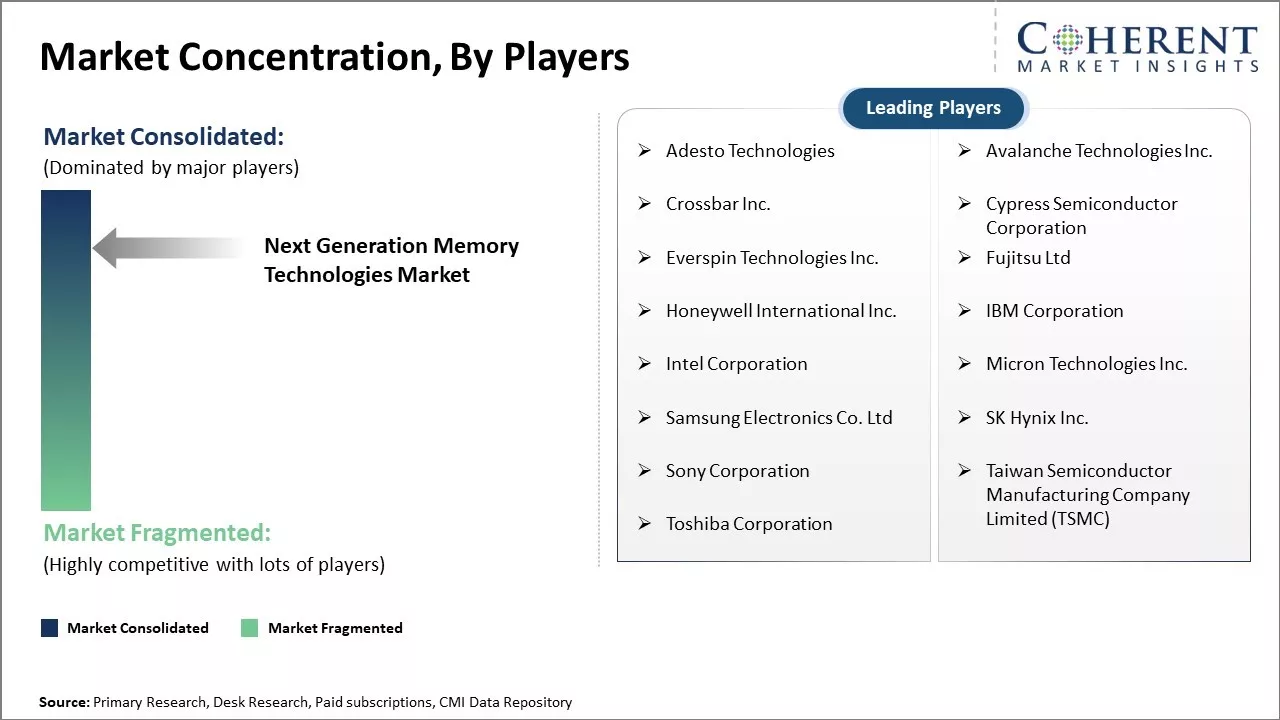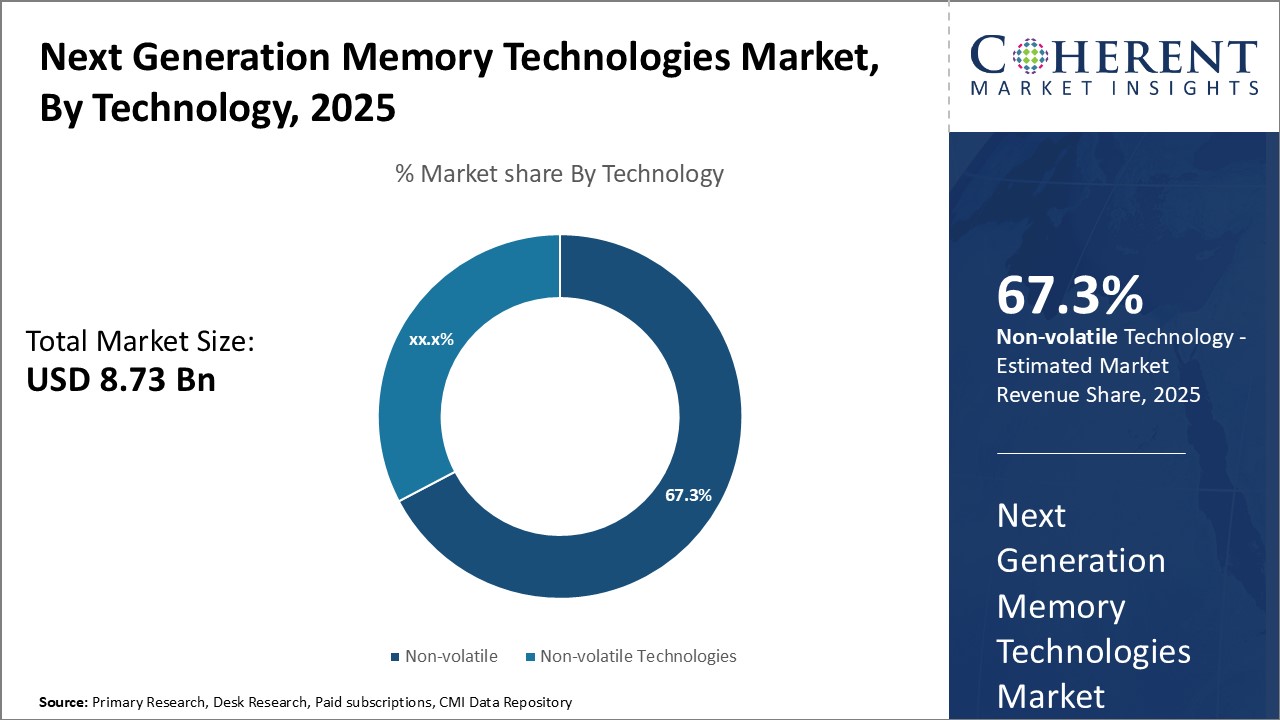The Next Generation Memory Technologies Market is estimated to be valued at USD 8.73 billion in 2025 and is expected to reach USD 50.51 billion by 2032, exhibiting a compound annual growth rate (CAGR) of 28.5% from 2025 to 2032.

Discover market dynamics shaping the industry: Request sample copy
The next generation memory technologies market growth can be attributed to rising demand for universal memory technologies among various end-use verticals. Memories with higher storage capacity, lower power consumption, and near zero latency will continue gaining traction. Significant investments in R&D of new opportunities such as redox-based memory and phase change memory are estimated to disrupt the status quo. Further, the growing adoption of autonomous vehicles, high-performance computing, and internet of things are anticipated to boost the next generation memory technologies market growth during the forecast period.
Rising Demand for High Bandwidth Memories
The ever-growing demand for high-performance computing applications is driving the need for memory technologies that can provide vastly higher data bandwidth and lower latency compared to existing solutions. Applications in rapidly developing areas such as artificial intelligence, machine learning, autonomous vehicles, and augmented and virtual reality require memory subsystems that can deliver massive amounts of data to GPUs and other data-intensive processors at unprecedented speeds.
For instance, in August 2023, SK Hynix Inc. a semiconductor company, intensified the semiconductor technology competition with its latest next-generation high-bandwidth memory (HBM). The company successfully developed the 5th generation DRAM product, HBM3E, designed for high-performance artificial intelligence (AI) applications. This advanced HBM chip enhances data processing speeds by vertically integrating multiple DRAMs, surpassing conventional DRAM capabilities.

Get actionable strategies to beat competition: Request sample copy
Growing Adoption in Data Centers and Cloud Infrastructure
Next-generation memory solutions like 3D XPoint, STT-MRAM, and ReRAM are being actively evaluated by leading cloud providers for deployment in memory/storage hierarchy as they promise significantly higher densities, lower latencies, and better endurance than NAND alone. Big data centers are adopting tiered storage architectures leveraging non-volatile memories to optimize for factors like performance, cost-effectiveness, and power-efficiency across different access granularities and use cases. Top cloud operators have already started deploying 3D X.
As investments in data centers continue to rise, North America is expected to remain a prime destination for next-generation memory providers. For example, in March 2022, Vantage Data Centers, a leading provider of hyperscale data center campuses, announced an additional investment of USD 721.1 million (CAD 900 million) to expand its Canadian operations. This investment includes the construction of a third campus in Montreal and the expansion of two existing campuses in Quebec City and Montreal.
Key Takeaways from Analyst:
The next generation memory technologies market is poised to experience significant growth in the coming years. Driven by the need for faster, higher density and more energy efficient memory solutions, technologies such as resistive random-access memory (ReRAM), 3D XPoint, and magnetoresistive RAM (MRAM) are expected to gain traction. ReRAM's ability to meet the performance requirements of both storage class memory and main memory make it an attractive alternative to NAND and DRAM. Meanwhile, 3D XPoint's ability to provide speeds closer to DRAM but at a lower cost than NAND is driving demand from data centers and enterprise applications.
However, high manufacturing costs and lack of scalability could hinder the mass adoption of these technologies in the near future. Additionally, the dominance of NAND in storage and DRAM in main memory remain a challenge. NAND and DRAM manufacturers are making significant R&D investments to improve the attributes of their established products, which may slow the customer transition to next generation technologies.
The data center memory market is expected to be the fastest growing application segment. This is due to increasing adoption of memory intensive applications like AI, big data analytics, and high-performance computing in the cloud. The Asia Pacific region currently dominates the manufacturing of memory ICs and is likely to continue leading investments in emerging technologies.
Market Challenges: Competition from Established Technologies and Challenges of New Entrants
NAND flash and DRAM technologies cast a long shadow over the next-generation memory market. Their established performance, reliability, and lower production costs make them the dominant players. This creates a significant hurdle for new entrants. Potential users are hesitant to adopt unproven technologies with potentially higher upfront costs for manufacturers. Next-generation solutions need to demonstrate consistent performance and reliability on a large scale, while simultaneously achieving competitive production costs, to gain wider market acceptance.
Market Opportunities: Addressing Evolving Needs and the Rise of Universal Memory Solutions
The data storage landscape is undergoing a significant shift. Across various industries, demands for higher density and advanced scaling in memory solutions are intensifying. This presents a crucial opportunity for next-generation memory technologies. They have the potential to address these growing needs more effectively than traditional options. Furthermore, the increasing complexity of electronic devices and the proliferation of Internet of Things (IoT) applications necessitate a new breed of memory solutions. Universal memory solutions, offering greater flexibility and adaptability to cater to diverse needs, will be highly sought after. Next-generation technologies that can bridge the gap between high density and adaptability will be well-positioned for significant market share gains.

Discover high revenue pocket segments and roadmap to it: Request sample copy
Insights, By Technology, Rising Dominance of Non-Volatile Memory in Next-Generation Technologies
The non-volatile segment of the next-generation memory technologies market is expected to dominate with a 67.3% share in 2025, driven by the need for data storage solutions that retain information without power. NAND flash memory, widely used in USB drives, SD cards, and SSDs, is pivotal due to its high capacity and cost-effectiveness.
The shift from HDDs to SSDs in laptops and desktops, along with the growing demand for digital content storage on portable devices, fuels this trend. Enterprises are increasingly adopting SSDs for data centers for faster input/output and lower power consumption. In the automotive sector, rising memory requirements for computer modules in vehicles also boost demand.
Emerging technologies like ReRAM and 3D XPoint promise even higher capacities and better performance, catering to the expanding needs driven by advancements in AI, virtual reality, and the Internet of Things. This will continue to propel the growth of non-volatile memory in the next-generation memory technologies market.
Insights, By Industry Vertical, Consumer Electronics Driving Memory Technologies
Consumer electronics, accounting for 28.01% in 2025, are fueled by devices like smartphones, tablets, laptops, and gaming consoles. DRAM and SRAM are vital for temporary storage and processing in these gadgets.
Smartphones, now digital hubs, demand substantial DRAM, especially flagship models with 12GB or more RAM. Gaming PCs and consoles also rely on high-speed GDDR memory for immersive experiences. Emerging tech like AR/VR headsets and wearables will further drive memory needs.
Software advancements and workload demands will continually push for higher-capacity, lower-power volatile memory in consumer tech, indicating sustained demand.

Need a Different Region or Segment? Customize now
Asia Pacific is estimated to hold the largest share of 42.6% in 2025, driven by the presence of leading foundries like Taiwan Semiconductor Manufacturing Company (TSMC) and major contract manufacturers in Taiwan, South Korea, and China. Heavy investments in next-generation memory production are fuelled by aggressive promotion of domestic semiconductor production through incentives and subsidies in these countries. Global tech giants are increasingly partnering with local players for memory manufacturing, further bolstered by strong growth in consumer electronics, automotive, and mobile device industries across the region. South Korea, Taiwan, and Japan have emerged as major export hubs for next-generation non-volatile memories, with competitive pricing and ease of availability encouraging technology adoption. Additionally, manufacturing facilities of companies like Samsung Electronics, SK Hynix, and Toshiba serve the growing demand from China, India, and Southeast Asian nations. Steadily improving IP protection and supportive government policies are further enhancing the region's next-generation memory market.
In contrast, North America is the fastest-growing region in the next-generation memory technologies market and is expected to exhibit a CAGR of 33.21% during the forecast period 2025-2031, driven by a strong presence of leading technology companies in the U.S. The region dominates global research and development activities in resistive RAM (RRAM), 3D XPoint, phase-change memory (PCM), and magnetoresistive RAM (MRAM). Major chipmakers like Intel, Micron Technology, and Hewlett-Packard are headquartered in the U.S. and have invested significantly in next-generation memory startups through venture funding and acquisitions. This investment ensures that the most advanced next-generation memory technologies are commercialized and manufactured in North America first. The robust electronics manufacturing ecosystem and substantial domestic demand for data centers and consumer electronics further fuel the adoption of next-generation memory in the region.
Next Generation Memory Technologies Market Report Coverage
| Report Coverage | Details | ||
|---|---|---|---|
| Base Year: | 2024 | Market Size in 2025: | USD 8.73 Bn |
| Historical Data for: | 2020 To 2024 | Forecast Period: | 2025 To 2032 |
| Forecast Period 2025 to 2032 CAGR: | 28.5% | 2032 Value Projection: | USD 50.51 Bn |
| Geographies covered: |
|
||
| Segments covered: |
|
||
| Companies covered: |
Adesto Technologies, Avalanche Technologies Inc., Crossbar Inc., Cypress Semiconductor Corporation, Everspin Technologies Inc., Fujitsu Ltd, Honeywell International Inc., IBM Corporation, Intel Corporation, Micron Technologies Inc., Samsung Electronics Co. Ltd, SK Hynix Inc., Sony Corporation, Taiwan Semiconductor Manufacturing Company Limited (TSMC), and Toshiba Corporation |
||
| Growth Drivers: |
|
||
| Restraints & Challenges: |
|
||
Uncover macros and micros vetted on 75+ parameters: Get instant access to report
Share
Share
About Author
As an accomplished Senior Consultant with 7+ years of experience, Pooja Tayade has a proven track record in devising and implementing data and strategy consulting across various industries. She specializes in market research, competitive analysis, primary insights, and market estimation. She excels in strategic advisory, delivering data-driven insights to help clients navigate market complexities, optimize entry strategies, and achieve sustainable growth.
Missing comfort of reading report in your local language? Find your preferred language :
Transform your Strategy with Exclusive Trending Reports :
Frequently Asked Questions
Joining thousands of companies around the world committed to making the Excellent Business Solutions.
View All Our Clients
US Reciprocal Tax Impact Analysis On Next Generation Memory Technologies Market
Stay updated on tariff changes with expert insights and timely information